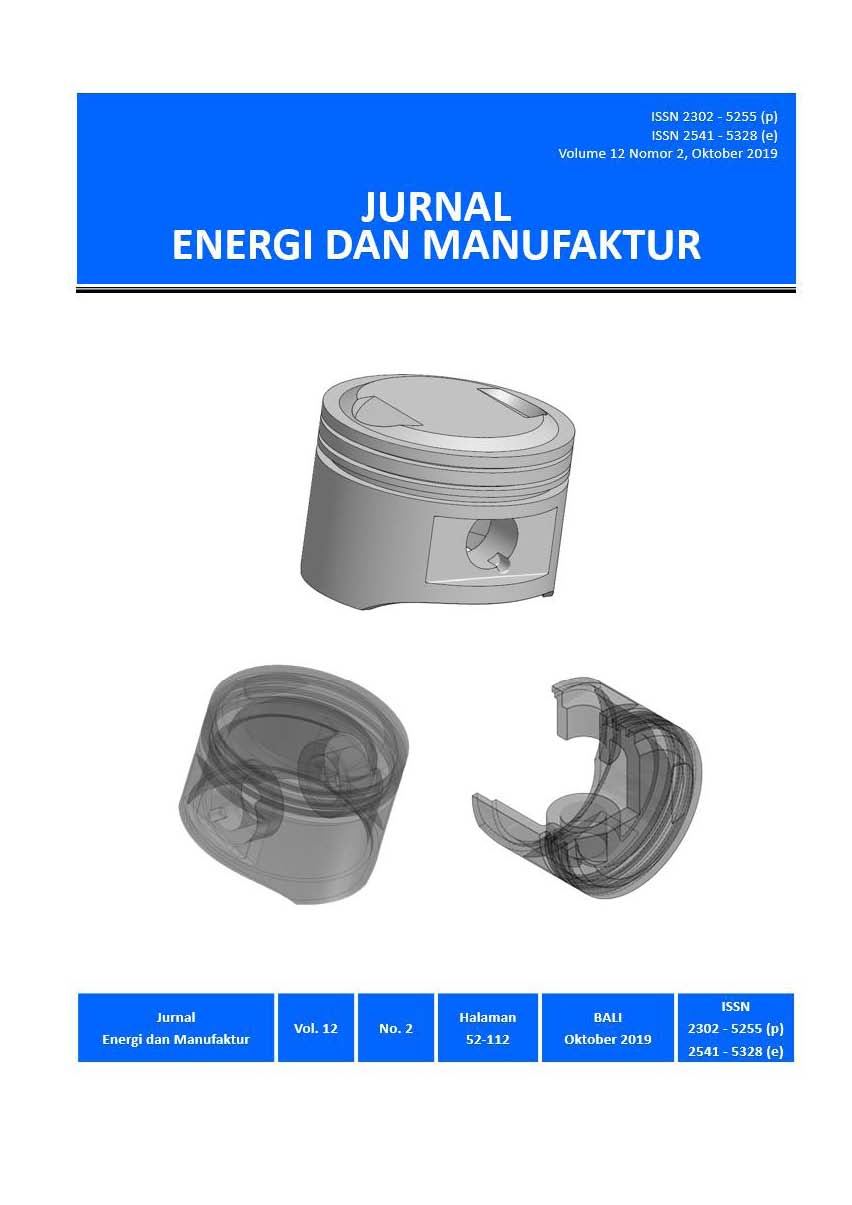Pengaruh Temperatur Aniling Material Mgalti Terhadap Media Penyimpan Hidrogen
Abstract
Hidrogen merupakan salah satu sumber energi alternatif di masa depan. Penyimpanan Hidrogen dalam bentuk solid state memiliki keunggulan daripada penyimpanan dalam bentuk gas dan cair. Penelitian ini dilakukan untuk mempelajari pengaruh material MgAlTi dan temperatur aniling material (MgAlTi) hasil preparasi reactive mechanical alloying (RMA) terhadap sifat media penyimpan hidrogen. Penambahan paduan logam Al dan Ti pada paduan logam Mg dilakukan untuk memperbaiki sifat serapan Mg. Penelitian dilakukan dengan memadukan material Mg, Al dan Ti dengan komposisi berat berturut-turut 85, 15 dan 5 %. Ketiga logam dipadukan dengan teknik RMA. Persiapan pemaduan dilakukan dalam glove box yang dialiri gas argon untuk memastikan pengerjaan teknik RMA dalam keadaan inert. Pemaduan teknik RMA dilakukan selama 10 jam dengan dialiri gas Hidrogen. Selanjutnya, paduan Mg85Al15+Ti5 di anil dengan variasi temperatur pemanasan 300; 340; dan 380 °C. Karakterisasi struktur kristal, mikro dan termal uji diobservasi dengan menggunakan X-Ray Difraction, SEM-EDX dan Differential Scanning Calorimetry (DSC). Hasil analisis struktur kristal dan mikro sesudah di aniling menjadi homogen dan hasil ini menunjukkan bahwa temperatur optimum material penyimpan hidrogen terjadi pada temperatur 300 °C. Aktifitas katalis terhadap disosiasi ikatan Mg-H2 dapat menentukan penurunan temperatur desorpsi dibandingkan pengaruh temperatur aniling. Pemaduan teknik RMA pada paduan logam MgAlTi dapat meningkatkan sifat-sifat penyimpanan hidrogen.
Hydrogen is an alternative energy source and it has advantages to storage the element in form of solid state compare gas and liquid. The study was conducted to analyse the effect of MgAlTi in aniling temperature used reactive mechanical alloying (RMA) for hydrogen storage. The experimental was carried out to improve the absorption Mg by combination of Mg, Al and Ti materials with 85, 15 and 5% weight composition. The preparation is carried out in the glove box which is flowed with argon gas to ensure the work of the RMA technique in an inert state. The RMA techniques is carried out for 10 hours with Hydrogen gas flowing. Thus, the Mg85Al15 + Ti5 alloy is annealed with a heating temperature variation of 300; 340; and 380 °C. Characterization of crystal structure, micro and thermal tests were observed using X-Ray Difraction, SEM-EDX and Differential Scanning Calorimetry (DSC). The results of analysis of the crystal and micro structures after aniling become homogeneous and this shows that the optimum temperature of the hydrogen storage material occurs at a temperature of 300 °C. Moreover, the catalyst activity against dissociation of Mg-H2 bonds can determine the decrease in desorption temperature compared to the effect of aniling temperature. The integration of RMA techniques in MgAlTi metal alloys can improve hydrogen storage.
Downloads
References
[2] J. Suls, “The Mechanics of Metal Hydride Hydrogen Storage Systems for Portable Applications,” in Proceeding of Fuel Cells Final Project, 2014.
[3] A. R. V. Babu, N. Devunuri, D. R. Manisha, Y. Prashanthi, R. Merugu, and A. J. R. R. Teja, “Magnesium Hydrides for Hydrogen Storage : A Mini Review,” Int. J. ChemTech Res., vol. 6, no. 7, pp. 3451–3455, 2014.
[4] P. Prachi’s, W. Mahesh, and G. Aneesh, “A Review on Solid State Hydrogen Storage Material,” Adv. Energy Power, vol. 4, no. 2, pp. 11–22, 2016.
[5] M. Lotoskyy et al., “An outstanding effect of graphite in nano-MgH2-TiH2 on hydrogen storage performance,” J. Mater. Chem. A View, no. 16, pp. 1–16, 2018.
[6] A. Ranjbar et al., “Hydrogen storage properties of MgH2 – SiC composites,” Mater. Chem. Phys., vol. 114, pp. 168–172, 2009.
[7] B. Sakintuna, F. Lamari-darkrim, and M. Hirscher, “Metal hydride materials for solid hydrogen storage : A review,” Int. J. Hydrogen Energy, vol. 32, pp. 1121–1140, 2007.
[8] J. Crivello, T. Nobuki, and T. Kuji, “Improvement of Mg–Al alloys for hydrogen storage applications Improvement of Mg–Al alloys for hydrogen storage applications,” Int. J. Hydrogen Energy, vol. 34, pp. 1937–1943, 2014.
[9] H. Yuan, Y. An, G. Xu, and C. Chen, “Hydriding behavior of magnesium-based hydrogen storage alloy modified by mechanical ball-milling,” Mater. Chem. Phys. 83, vol. 83, pp. 340–344, 2004.
[10] Zulkarnain, “Material Penyimpan Hidrogen Sistem MgH2-SiC yang dipreparasi melalui rute Reactive Mechaical Alloying,” Universitas Indonesia, 2011.
[11] M. Lucaci, A. R. Biris, R. L. Orban, G. B. Sbarcea, and V. Tsakiris, “Effects of mechanical alloying on the hydrogen storage properties of the Mg76Ti12Fe12−xNix (x = 4 , 8) materials,” J. Alloys Compd., vol. 488, pp. 163–168, 2009.
[12] X. Yu, Z. Tang, D. Sun, L. Ouyang, and M. Zhu, “Progress in Materials Science Recent advances and remaining challenges of nanostructured materials for hydrogen storage applications,” Prog. Mater. Sci., vol. 88, pp. 1–48, 2017.
[13] Y. Wang, S. Lu, Z. Zhou, W. Zhou, J. Guo, and Z. Lan, “Effect of transition metal on the hydrogen storage properties of Mg–Al alloy,” J. Mater. Sci., vol. 52, pp. 2392–2399, 2017.
[14] Stevenson, “Heat Treating of Magnesium Alloys (on ASM Handbook Volume 4 Heat Treating),” ASM Handbook Committee, 1991.
[15] M. Tanniru, H. Tien, and F. Ebrahimi, “Study of the dehydrogenation behavior of magnesium hydride,” Scr. Mater., vol. 63, pp. 58–60, 2010.
[16] M. V. Antisari, A. Montone, A. Aurora, M. R. Mancini, D. M. Gattia, and L. Pilloni, “Intermetallics Scanning electron microscopy of partially de-hydrogenated MgH2 powders,” Intermetallics, vol. 17, no. 8, pp. 596–602, 2009.
[17] Z. Yanghuan, Z. Tingting, Y. Tai, and Y. Zeming, “Improved Hydrogen Storage Kinetics of Nanocrystalline and Amorphous Mg-Nd-Ni-Cu- based Mg2Ni-type Alloys by Adding Nd,” J. Wuhan Univ. Technol. Sci. Ed., vol. 30, no. 6, pp. 1115–1124, 2015.
[18] R. A. Varin and L. Zbroniec, “The effects of ball milling and nanometric nickel additive on the hydrogen desorption from lithium borohydride and manganese chloride (3LiBH4 + MnCl2) mixture,” Int. J. Hydrogen Energy, vol. 35, no. 8, pp. 3588–3597, 2010.

This work is licensed under a Creative Commons Attribution-NonCommercial-ShareAlike 4.0 International License.









